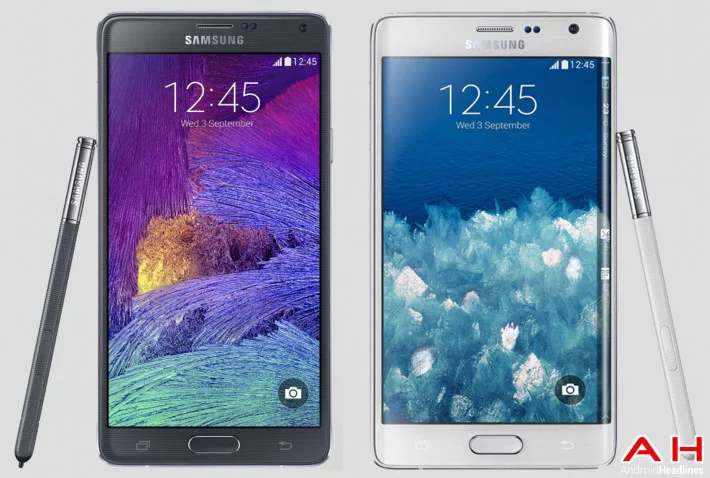Whenever a manufacturer releases a new smartphone, you can be sure that DisplayMate Technologies will put its display through its paces, testing every nuance of the display, in detail, and then they present those findings to the public. Make no mistake, they know what they are talking about: “DisplayMate is an industry standard for optimizing, calibrating, testing, evaluating and comparing all types of displays, monitors, projectors, mobile displays, HDTVs, and all display technologies, such as LCD, OLED, 3D, LED, LCoS, Plasma, DLP and CRT.”
This time around, DisplayMate Technologies looks at the Samsung Galaxy Note Edge and Galaxy Note 4 to see how good each display is on their own and then compares the two and I think the findings will surprise our AMOLED display doubters…once again. DisplayMate recently tested the Samsung Galaxy S5 display and proclaimed it as the best they have ever tested – will the Galaxy Note 4 or Galaxy Note Edge stand up to the high standards set by the Galaxy S5? Let’s take a look at the highlights from their testing and if you want to read the entire article, look at all of the graphs and test results, you can read it here.
Both displays use the Organic Light-Emitting Diode (OLED) technology. The main difference between the Galaxy Note Edge and Galaxy Note 4’s displays are their substrates – the Note Edge display is on a flexible plastic substrate and the Note 4 uses a traditional glass substrate. We were confident the Note 4 would perform well based on the Galaxy S5 test results, but the real question we had was how would the flexible plastic OLED of the Note Edge perform against its glass substrate’s brother. We will first take a look at the general characteristics of each display and then the general test results for each will follow.
Galaxy Note 4: DisplayMate says that Samsung has systematically continued to improved their (AM)OLED displays with each Galaxy generation since 2010. Just as there were significant improvements between the Galaxy S4 and Galaxy S5, there were just as many improvements from the Galaxy Note 3 to the Galaxy Note 4. Obviously, the most impressive improvement are the pixels-per-inch (ppi) and resolution, the Absolute Color Accuracy, Peak Brightness, and screen view ability in High Ambient Light, and display Power Efficiency. The Note 4 has a Quad HD 2560 x1440 pixel display, currently the highest resolution for Smartphones, giving the Note 4 about 518 ppi. It is capable of displaying four complete HD 1280×720 images at once.
Galaxy Note 4 Conclusions: The primary goal these display tests is too see which manufacturers and display technologies are leading and advancing the state-of-the-art displays. In just a span of four years the OLED display technology is not only challenging, but is actually exceeding the performance of the best LCDs. Based on their extensive Lab tests and measurements, “the Galaxy Note 4 is the Best performing Smartphone display that we have ever tested. It matches or breaks new records in Smartphone display performance for: Highest Absolute Color Accuracy, Highest Screen Resolution, Infinite Contrast Ratio, Highest Peak Brightness, Highest Contrast Rating in Ambient Light, and the smallest Brightness Variation with Viewing Angle. Its Color Management capability provides multiple Color Gamuts – a major advantage that is not currently provided by any of the other leading Smartphones.” Not my words, but DisplayMate’s.
Some critics say that OLED displays are oversaturated and they do not show true colors – words that were true a couple years ago, but DisplayMate proves that is not true any longer. They said that the Galaxy Note 4’s Basic screen mode “has the most accurate colors for Standard (sRGB) consumer content of any Smartphone or Tablet display that we have ever measured.” They measured a 14-percent improvement in display power efficiency from the Note 3 to Note 4. LCDs are still more efficient with mostly white backgrounds, such as a text screen, when looking at mixed content, such as photos, videos or movies; the Galaxy Note 4 is 40-percent more efficient than Full HD LCD displays. If this keeps up, then OLEDs may pull ahead of LCDs in total power efficiency in the near future.
Galaxy Note Edge: The Note Edge has a very innovative curved OLED display that wraps around the right edge of the display. This curved edge is a separate, configurable display area that can be viewed when looking at the display either from the front or from the side. It can display and interact with “widgets, apps, menus, controls, icons, favorites, social media, notifications, stock tickers, and news feeds.” You can also setup seven customized Edge panels. DisplayMate claims it is “quite functional and useful.” Because the displays can operate independently from one another, even with the main display turned off, you can still keep the side display turned on to view notifications, messages or other alerts. The Note Edge has a single 2560 x 1600 OLED display with 540 ppi that is configured as two displays via software, with a resolution of 2560 x 1440 for the main display and 2560 x 160 for the Edge display. The flexible plastic display is placed under a solid piece of Gorilla Glass 3, for protection and to keep the flexible display’s shape.
Conclusions for Galaxy Note Edge: DisplayMate tests results show that the performance OLED display on a flexible plastic substrate is now essentially the same as on the traditional glass substrate used on the Note 4 even with 500+ ppi and a 2560 x 1600 resolution. DisplayMate also points out the flexible and curved displays are definitely the wave of the future because they offer so many advantages over a flat display…this applies to both mobile and TV displays.
So there we have it – DisplayMate Technologies has now crowned the Galaxy Note 4 the best display they have ever tested and the flexible plastic display on the Galaxy Note Edge tests “essentially the same” as the Note 4. Two new flagship devices are the new forces to be reckoned with for the near future. For the complete and thorough test results with all measurements and graphs, visit their website at the link above or click on our source below. Please hit us up on our Google+ Page to discuss the AMOLED vs LCD debate…as always, we would love to hear from you.

